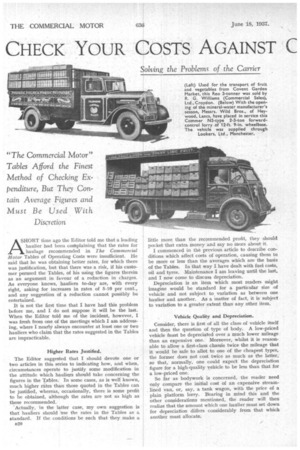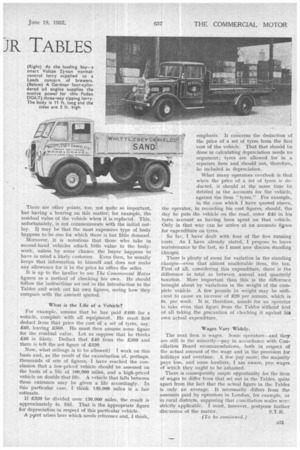CHECK YOUR COSTS AGAINST C )R TABLES
Page 54

Page 55

If you've noticed an error in this article please click here to report it so we can fix it.
Solving the Problems of the Carrier
"The Commercial Motor" Tables Afford the Finest Method of Checking Expenditure, But They Contain Average Figures and Must Be Used With
Discretion
SHORT time ago the Editor told me that a leading haulier had been complaining that the rates for
haulage recommended in The Commercial Motor Tables of Operating Costs were insufficient. He said that he was obtaining better rates, for which there was justification, but that there was a risk, if his customer perused the Tables, of his using the figures therein as an argument in favour of a reduction in charges. As everyone knows, hauliers to-day are, with every right, asking for increases in rates of 5-10 per cent., and any suggestion of a reduction cannot possibly be entertained.
It is not the first time that I have had this problem before me, and I do not suppose it will be the last. When the Editor told me of the incident, however, I was fresh from one of the meetings which I am addressing, where I nearly always encounter at least one or two hauliers who claim that the rates suggested in the Tables are impracticable.
Higher Rates Justified.
The Editor suggested that I should devote one or two articles in this series to indicating how, and when, circumstances operate to justify some modification in the attitude which hauliers should take concerning the figures in the Tables. In sonic cases, as is well known, much higher rates than those quoted in the Tables can be justified, whereas, occasionally, there is some profit to be obtained, although the rates are not as high as those recommended.
"Actually, in the latter case, my own suggestion is that hauliers should use the rates in the Tables as a standard. If the conditions be such that they make a n20
little more than the recommended profit, they should pocket that extra money and say no more about it.
I commenced in the previous article to describe conditions which affect costs of operation, causing them to be more or less than the averages which are the basis of the Tables. In that way I have dealt with fuel costs, oil and tyres. Maintenance I am leaving until the last, and I now come to discuss depreciation.
Depreciation is an item which most readers might imagine would be standard for a particular size of vehicle and not subject to variation as between one haulier and another. As a matter of fact, it is subject to variation to a greater extent than any other item.
Vehicle Quality and Depreciation.
Consider, there is first of all the class of vehicle itself and then the question of type of body. A low-priced vehicle inust be depreciated over a much lower mileage than an expensive one_ Moreover, whilst it is reasonable to allow a first-class chassis twice the mileage that it would be safe to allot to one of the cheapest types, the former does not cost twice as much as the latter, so that, normally, one could expect the depreciation figure for a high-quality vehicle to be less than that for a low-priced one.
So far as bodywork is concerned, the reader need only compare the initial cost of an expensive streamlined van, or, say, a tank wagon, with the price of a plain platform lorry. Bearing in mind this and the other considerations mentioned, the reader will then realize that the amount which one haulier must set. down for depreciation differs considerably from that which another must allocate. There are other points, too, not quite so important, but having a bearing on this matter; for example, the residual value of the vehicle when it is replaced. This, unfortunately, is not commensurate with the initial outlay. It may be that the most expensive type of body happens to be one for which there is but little demand.
Moreover, it is notorious that those who take in second-hand vehicles attach little Value to the bodywork, unless by some chance the buyer happens to have in mind a likely customer. Even then, he usually keeps that information to himself and does not make any allowance for it in the price he offers the seller.
It is up to the haulier to use The Commercial Motor figures as a method of checking his own. He should follow the instructions set out in the introduction to the Tables and work out his own figures, seeing how they compare with the amount quoted.
What is the Life of a Vehicle?
For example, assume that he has paid £400 for a vehicle, comialete with all equipment. He must first deduct from that price the cost of a set of tyres, say, £40, leaving £360. He must then assume some figure for the residual value. Let us suppose that he thinks £40 is likely. Deduct that £40 from the £360 and there is left the net figure of £320.
Now, what mileage is to be allowed? I work on this basis and, as the result of the examination of, perhaps, thousands of sets of figures, I have reached the conclusion that a low-priced vehicle should be assessed on the basis of a life of 100,000 miles. and a high-priced vehicle on double that life. A vehicle that falls between those extremes may be given a life accordingly. In this particular case, I think 130,000 miles is a fair estimate.
If £320 be divided over 130,000 miles, the result is approximately 4s. 10d. That is the appropriate figure for depreciation in respect of this particular vehicle.
A p9int arises here which needs reference and. I think, emphasis. It concerns the deduction ol the price of a set of tyres from the first cost of the vehicle. That that should be done in calculating depreciation needs no argument; tyres are allowed for in a , • separate item and should not, therefore, be included in depreciation.
What many operators overlook is that when the price of a set of tyres is de ducted, it should at the same time be debited in the accounts for the vehicle, against the item "tyres." For example, in the case which I have quoted above, the operator, in recording his cost figures, should, the day he puts the vehicle on the road, enter £40 in his tyres account as having been spent on that vehicle. Only in that way can he arrive at an accurate figure for expenditure on tyres.
So far, I have dealt with four of the five running costs. As I have already stated, I propose to leave maintenance to the last, so I must now discuss standing charges.
There is plenty of room for variation in the standing charges—even that almost unalterable item, the tax. First ,:of all, eonsidering this expenditure, there is the difference irt total as between annual and quarterly taxation. More important than this is the difference brought about by variations in the weight of the complete vehicle. A few pounds in weight may be stifficient to cause an increase of £20 per annum, which is 3s. per week. It is, therefore, unsafe for an operator to take even that figure from the Tables without first of all taking the precaution of checking it against his own actual expenditure.
Wages Vary Widely.
The next item is wages. Some operators—and they are still in the minority—pay in accordance with Conciliation Board recommendations, both in respect of the actual amount of the wage and in the provision for holidays and overtime. A few pay more; the majority pays less, and sonic hauliers, I am aware, pay wages cf which they ought to be ashamed.
There is consequently ample opportunity for the item of wages to differ from that set out in the Tables, quite apart from the fact that the actual figure in the Tables is only an average. It necessarily differs from the amounts paid by operators in London, for example, or in rural districts, supposing that conciliation scales were strictly applicable. I must, however, postpone further discussion of the matter. S.T.R.




























































































